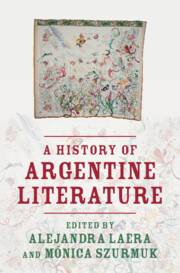Book contents
- A History of Argentine Literature
- A History of Argentine Literature
- Copyright page
- Contents
- Figures
- Contributors
- Editors’ Acknowledgments
- Introduction
- Part I Literary Dates
- Part II Critical Inroads
- Chapter 11 Print Culture in the Nineteenth Century
- Chapter 12 Criollismo: Gauchos in Literature and Film
- Chapter 13 Race and Nation
- Chapter 14 Science in Argentine Literature
- Chapter 15 Essay and Territory: The Geography of National Identity
- Chapter 16 Music as Sonic Literature
- Chapter 17 The Jewish Presence in Argentine Literature
- Chapter 18 Emancipation: Twentieth-Century Female Writers, Journalists, and Activists
- Chapter 19 Forsaking Tradition: Dislocating the Sovereignty of Argentine Literature
- Chapter 20 Mujeres raras: Patriarchal Nightmares, Dissident Imagination
- Part III Literary Names
- Index
- References
Chapter 16 - Music as Sonic Literature
from Part II - Critical Inroads
Published online by Cambridge University Press: 09 May 2024
- A History of Argentine Literature
- A History of Argentine Literature
- Copyright page
- Contents
- Figures
- Contributors
- Editors’ Acknowledgments
- Introduction
- Part I Literary Dates
- Part II Critical Inroads
- Chapter 11 Print Culture in the Nineteenth Century
- Chapter 12 Criollismo: Gauchos in Literature and Film
- Chapter 13 Race and Nation
- Chapter 14 Science in Argentine Literature
- Chapter 15 Essay and Territory: The Geography of National Identity
- Chapter 16 Music as Sonic Literature
- Chapter 17 The Jewish Presence in Argentine Literature
- Chapter 18 Emancipation: Twentieth-Century Female Writers, Journalists, and Activists
- Chapter 19 Forsaking Tradition: Dislocating the Sovereignty of Argentine Literature
- Chapter 20 Mujeres raras: Patriarchal Nightmares, Dissident Imagination
- Part III Literary Names
- Index
- References
Summary
This chapter makes a case for integrating some musical narratives – both verbal and audiovisual – into the field of Argentine literature. After considering the case of Luis Alberto Spinetta’s 1973 “Cantata de puentes amarillos,” a song generally valued as a poetic achievement, it highlights the historical role of five iconic music works: the Himno Nacional, the national anthem written in 1813 by Vicente López and Blas Parera, which inaugurated a state ritual based on the alleged epic value of personal sacrifice; “Mi Noche Triste,” a tango recorded by Carlos Gardel in 1917, which describes a beloved woman’s absence from the perspective of a suffering male narrator, thus nourishing a topos of gender relations in popular culture; Estancia, a classical ballet composed by Alberto Ginastera in 1941, which displays the nationalist myth of Argentina’s rural authenticity; “Manuelita la Tortuga,” a children’s song by María Elena Walsh, the story of a female turtle who travels to Paris in order to be made beautiful; and Charly García’s “No bombardeen Buenos Aires,” a rock song that in June 1982 proposed a critical view of the Malvinas/Falklands War, contributing to the negative memory of the dictatorship of 1976–83.
- Type
- Chapter
- Information
- A History of Argentine Literature , pp. 245 - 257Publisher: Cambridge University PressPrint publication year: 2024



